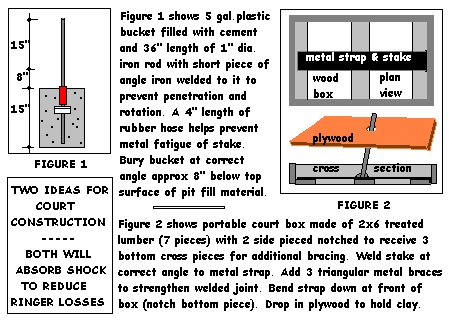 Professional Court
Construction
Professional Court
Construction

Legend Homepage
Court
Contstruction
page
Well constructed courts and routine
maintenance can only enhance pitcher
enjoyment and tournament interest.....
The 4 primary elements of good courts are
Stakes - Pit Material - Platforms - Fencing....
Whether you, your club or your Parks & Recreation Department plan
to build or remodel horseshoe courts, good planning should be done in
advance...
Site selection and grading should call for reasonably level ground with
suitable drainage away from the pits and walkways.
The actual court "playing area" measures from the back of the pitching
platform to the back of the opposite pitching platform at the other end
of the court and the 6 ft width of the pitchers box. Additional
suitable space is necessary for safety...Space courts at least 10 ft
(preferably 12 ft) apart measured stake to stake... Construct chainlink
fencing across both ends of the courts at least 8 ft (preferably 10 ft)
measured from the stakes.
Backstops are often used for containment of loose pit material but they
also stop shoes which may have hit and bent the chainlink fence.
Fence gates should be located between courts and if practical, located
every 2nd court to give pitchers a safe, direct exit from their court
without crossing adjacent courts.
Surrounding yard areas should be graded level with or slope away from
walkways to eliminate ledges and steps that may cause ankle injuries.
If practical, the paved pitching platforms should extend the full
length of the court as continuous walkways. The surrounding areas may
be gravel packed, seeded or paved. Construction joints in paved
walkways should be accurately positioned to act as foul lines or
pitching platform dimensions, otherwise painted lines will be
necessary.
"In-ground" courts should have top of pit fill material level with
pitching platforms. "Portable" (aka "temporary" and "raised") courts
have a maximum height limit of 7 in. above the pitching platform
surface. Some portable courts have a slight adjustment in the pitching
distance to compensate for the raised height of the pit and some
portable courts eliminate much of the front edge of the "box" which
otherwise blocks a view of the pit surface.
LIGHTING GUIDELINES Horseshoe court lighting should be uniform over the
playing surface and for a few feet outside the side lines and
backstops. Outdoor lighting offers no reflective background so all
light must be direct from the fixtures. For club/tournament play, 25 to
35 footcandles is recommended, and for non-tournament play 15 to 25
footcandles is sufficient. All the surface area should be evenly
lighted. Lighting fixtures should be placed outside of all courts so
that beams are generally aimed across the courts. No light sources
should be located directly behind the courts or at the back corners of
courts if possible. Quartz, metal halide, fluorescent, and high
pressure sodium lamps are all applicable to horseshoe court lighting.
Poles should be 30 to 35 ft long, have cross arms at the top to which
fixtures are attached, and be capable of withstanding at least 100-mph
winds. Fluorescent fixtures should be mounted 14 to 16 ft above the
court surface, outside the lines and tilted inward. Pole mounted
fluorescent fixtures may be located 22 ft above the court surface.
Poles should be primed and painted a dark color. All wiring should be
installed underground and outside the court area. Basic design
techniques are the same for almost any type of field.
Horseshoe pitching tournaments
normally have "class" sizes of 6, 8, 10, 12 and 16 pitchers. Each
"class" pitches a "round-robin" schedule where each contestant pitches
one game against other in the same "class". Thus, a 6-man class would
need 3 courts; an 8-man class would need 4 courts; etc. Accordingly,
court installations should be constructed with enough courts to handle
the largest anticipated tournament. For example, if 40 entries were
expected they could be divided into five 8-man classes requiring 20
courts. Alternately, two 8-man morning classes and three 8-man
afternoon classes would require no more than 12 courts. (Suggested:
minimum of 18 to 24)
 Possible stake assembly
details
Possible stake assembly
details

|